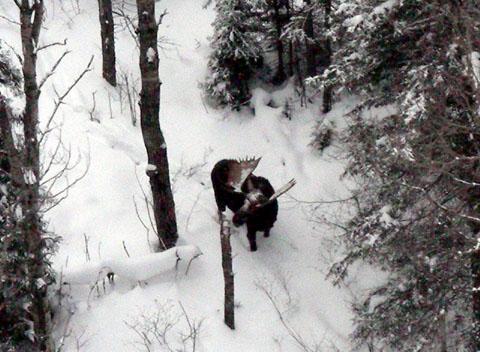How many moose reside in Voyageurs National Park? Well, the 2009 winter survey spotted 45 Alces alces, but biologists believe that translates to a park-wide population of at least 80.
The problem, you see, is that at this time of year, 50 percent or more of the park's moose are hunkered down under stands of conifers, making it hard for the aerial spotters to get a hard and fast count.
Steve Windels, Voyageuers' terrestrial ecologist, conservatively estimates that at least 80 moose make Voyageurs home.
“We are pleasantly surprised with the total number of moose we observed,” said Windels. “Based on moose population declines in the region, many of us were prepared for the worst. We would have liked to have seen more calf/cow pairs, but they may have been in cover during the survey. We also saw more bulls than cows, possibly for the same reason.”
During the latest survey, which was completed in January, spotters counted just three calves and noted that not all bulls had dropped their antlers. The survey was the first complete moose survey of Voyaguers since 1992, a year when the park's moose population was thought to fall between 35 and 72 individuals.
Voyageurs managers are concerned about the long-term viability of the park's moose population given recent declines in moose populations in other parts of Minnesota and adjacent Ontario. Factors possibly causing these declines include chronic stress related to warmer summer and winter temperatures and lethal effects of parasites transmitted by white-tailed deer, such as brainworm and liver flukes.
The recent survey kicks offs a multifaceted project funded by the National Park Service and the U.S. Geological Survey that will provide Voyageurs biologists with information about these potential threats to the persistence of moose in the park.
“Moose seek cooler temperatures on hot summer days. We will use GPS radio collars to measure movement, activity, and habitat use by moose in Voyageurs National Park next year,” said Ron Moen, a biologist at the Natural Resources Research Institute at the University of Minnesota, Duluth. “We will be able to identify forest types that moose use as thermal cover when it is too hot for them to feed.”
The recent moose survey also enabled spotters to count 250 white-tailed deer. Deer numbers have generally increased in northern Minnesota in the last 20 years and the study will help biologists assess changes in the relative number and distribution of deer within the park over that time.


 Support Essential Coverage of Essential Places
Support Essential Coverage of Essential Places







Add comment